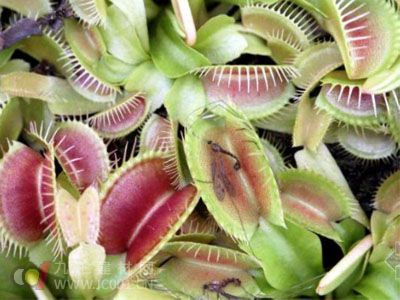Method of Breeding Flytraps:
Sexual Reproduction: The Venus flytrap can be self-pollinated, but it’s more common to use artificial pollination. However, success is not guaranteed because timing plays a crucial role. When the flower first opens, the stamens are usually mature, but the pistil isn’t yet ready for pollination. This means that pollinating too early won’t work. The pistil typically matures one day after the stamens, so the best time to pollinate is the following day. You can also check the appearance of the stigma—on an immature pistil, it’s round, while on a mature one, it splits into small lobes. Only mature pistils will accept pollen and produce seeds.
If pollination is successful, the flower will wither within 1–2 days, and the ovary at the base of the pistil will begin to swell. After several weeks, the fruit will develop, containing dozens of black, elongated seeds. The number of seeds depends on the health and size of the plant—stronger plants tend to produce more. However, even with proper pollination, some plants may fail to produce seeds due to weak health or insufficient light during flowering. It’s important to ensure the plant is vigorous and well-lit throughout this process.

Venus flytrap seeds don’t last long, so it’s best to plant them as soon as possible after harvesting. If you want to crossbreed different varieties, but the plants aren’t in bloom at the same time, you can collect and store the pollen in the refrigerator to extend its viability.
Flowering is a nutrient-intensive process, so it’s wise to remove the flower stalks if you’re aiming to grow large, healthy plants. This prevents the plant from wasting energy on blooming. Some weakened plants may still flower, but in such cases, it’s better to cut the stems off to protect the plant’s overall health.
Asexual Reproduction:
Leaf Insertion: One of the most popular methods for propagating Venus flytraps is leaf insertion. In spring and early summer, when the plant is actively growing, you can take a petiole (the stem-like part of the leaf) and place it in a moist medium. The insect-trapping part of the leaf is attached to the petiole, and both should be buried in the soil. Keeping the environment humid and providing bright, indirect light helps encourage new growth. After several weeks, small shoots may appear.
The process is slow, so patience is key. As long as the petiole doesn’t rot or turn black, keep it in the medium. Since the petiole has no roots at this stage, maintaining moisture is essential. Using a damp medium or placing it on a tray of water can help. Light is also important, but avoid direct sunlight, which could dry out or overheat the petiole.
The age of the petiole affects the success rate. Petioles from mature leaves have the highest chance of producing new plants, while older or younger leaves are less likely to sprout. When taking a petiole, try to include a small root if possible, as this increases the chances of success. To prevent rot, use clean, sterile media like sphagnum moss. Once the seedling is strong enough, you can transplant it into a new pot.
Ramets: Venus flytraps often produce lateral buds. When these buds grow large enough with their own roots, they can be separated from the parent plant and grown independently. However, some cultivated varieties rarely produce these offsets.
Flower Buds: Interestingly, sometimes the flower buds of a Venus flytrap can develop into a new plant! This phenomenon occurs due to temperature fluctuations. If there's a significant difference between day and night temperatures, the flower bud might start growing into a new plant. At that point, you can carefully cut it off and plant it to grow a new flytrap. This is a unique and fascinating way to propagate these carnivorous plants.
Double Glazing Intelligent Glass
Double Glazing Intelligent Glass,Laminated Double Glazed Smart Glass,Pdlc Double Glazing Intelligent Glass,Pdlc Smart Laminated Double Glazing Glass
Shenzhen YuGuang New Material Co.,Ltd , https://www.ygsmartfilm.com